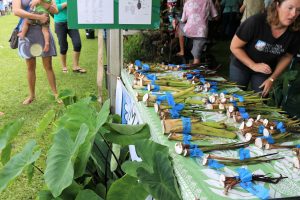Taro Farmers Get Ready for Queen’s Challenge Taro Competition
The 26th annual East Maui Taro Festival will take place Saturday, April 21, 2018 at the Hāna Ballpark, adjacent to the Travaasa Hāna Resort.
The free festival celebrates taro, a staple of the Hawaiian diet, and features a farmers market, kalo pounding, food booths, arts and crafts, live music, and hula.
The Queen’s Challenge Taro Competition will also take place on Saturday with a $500 prize at stake.
The Queen’s Challenge is open to all taro farmers on Maui growing Hawaiian taro varieties in two categories— wetland or dryland. There is no cost to enter the contest.
Entries must be Hawaiian taro varieties found in Bulletin 84: Taro Varieties in Hawaiʻi (1939) and a two-point advantage will go to taro grown organically in honor of Queen Emma’s proficiency in growing kalo and caring for the soil.
Event organizers say Maui Lehua, other hybrids, and non-Hawaiian varieties will not be accepted. To confirm your kalo variety check with the descriptions in Bulletin 84.
Participants who cannot attend the event can have a representative, however, they must list the growers name. Entries that are misrepresented will be disqualified.
The whole plant will be judged, organizers ask participants to not separate the corm from the stem. The corm must be free of ʻohā, roots and dirt. The hā and lau (stems and leaves) should be free of insects and soil. Kalo will be judged for weight, size and quality (not overripe or loli, uniformity, lack of scars or rots; plant vigor). Scoring will be a combination of these elements.
Growers or their representatives will need to provide the following information at entry no later than 11 a.m. to the E kūpaku ka ʻāina contest table:
1. Name of the grower, mailing address, phone and email contact
2. Place the taro was grown/ahupua‘a
3. Soil inputs and/or fertilizers used to grow the kalo entered in the contest
4. Wetland or dryland
5. Age of the taro at harvest (months), and, answer the following question:
6. Why do you grow kalo?
Anything received after 11 a.m. will not be accepted in the competition. Questions can be directed to E kūpaku ka ʻāina at: [email protected] (808) 285-3947

Queen Emma, Honolulu, Hawaii albumen silver photograph. Hawaii State Archives credits A. A. Montano, while Bishop Museum credits J. J. Williams.
Born in 1836, Queen Emma Kalanikaumakaamano Kaleleonālani Na‘ea Rooke was much loved by the people of Hawai‘i. She was also an expert in the planting and growing of kalo.
In an unpublished manuscript written by the Queen, believed to be in the 1860’s, entitled “Observations on Varieties and Culture of Taro” (Bishop Museum Archives), she describes in detail the planting methods, varieties favored at the time, the harvesting of kalo and preparing of poi, as well as an important discussion on the “productiveness” of the kalo. Organizers say it is in her manuscript that her knowledge of the conditions and practices of growing kalo shine. And, it is in her manuscript that the challenge to the taro farmers of today lays wait, for she is clear that it is in the caring of the soil that the greatest of taro sizes can be achieved.
Queen Emma writes: “The size of the roots depend upon the depth of loose soil, and the care bestowed on its cultivation. I have produced kalo which averaged twenty-two inches in length and the same in circumference when it was cultivated under my own eye, but far less in the same locality when the cultivation was somewhat neglected by my konohiki.”











